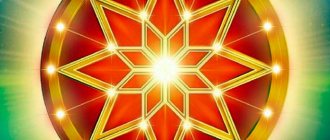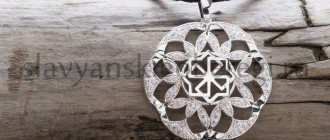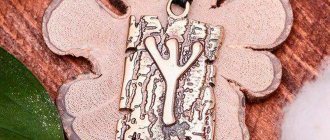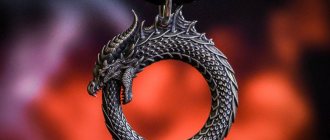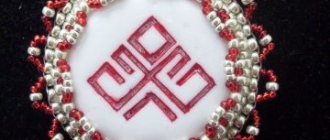In this article, Vedagor answers the question “What does an amulet with a snake mean?”
Not a single esoteric attribute will ever come close in terms of its versatility to an amulet in the form of a snake - so many meanings are intertwined in this symbol that the most experienced researchers are lost. This is both absolute Evil and perfect Good, wisdom and deceit, powerful defense and deadly attack.
Discussions about the essence of the symbol are akin to the eternal debate about the nature and differences between white and black magic. It all depends on the angle of view of the beholder: the snake is both the beginning of all things and the heavenly Dragon guarding our Universe. This is the demon-tempter from the Garden of Eden and the three-headed Gorynych from Russian fairy tales, whose regular mention speaks of obvious ancestor worship.
The origins of Christianity and snake symbolism
Such sacred items were kept in families for many generations, meaning for their owners the protection of the family. Fathers passed them on to their sons after death. If the family line was interrupted and there were no heirs left, the snake amulet was buried along with the last owner. Today, some talismans of those times can be admired not only in museums, but also in Christian cathedrals. For example, in the Trinity-Sergius Lavra there is kept a serpentine of Ivan the Terrible, carved from jasper.
This is not an isolated case: even the bishops of those hoary times did not disdain such protection, combining a snake and a stone into a talisman of unprecedented power. Its effectiveness is evidenced by the fact that the church, strenuously eradicating any echoes of paganism, turned a blind eye to the serpentines, recognizing them as fully worthy of proximity to the faces of Saints, prayers and crosses.
Semargl - patron
Semargl is the patron of the Serpent's Hall and is considered the highest deity, who has control over fire . He acts as an intermediary between the mortal inhabitants of the earth and the gods. Due to his strength, he is recognized as the protector of humanity. Every night, the patron of the Hall goes on patrol with his fiery sword, preventing evil from entering the human world.
The Fire God carefully monitors that his admirers observe all the prescribed fire rituals and do not miss purification. Semargl loves when sacrifices are made to him. But, like any other Slavic god, in this case he does not tolerate the useless bloodshed of animals or birds.
Semargl in two guises
The ancient Slavs turned to him for help if they were in dire need of healing the body and soul: their own, a loved one or a beloved pet. The Patron of the sacred Hall is kind and merciful to those who follow his commandments. Therefore, he could respond to the request and strengthen the health of any creature, saving him from suffering. After asking and reading a prayer, the patient was taken to the bathhouse. After all, according to existing beliefs, only through the heat of the Fire God could one be cured.
Semargl looks like a horseman riding a silver horse . In his hands is a banner of thick smoke. Where God passed in anger, scorched earth remained. According to legends, he could turn into a winged dog in order to fly around the sky over his possessions.
World interpretation – unity of contradictions
Many peoples proudly reported in fairy tales, chronicles, and religious texts that they descended from a certain Serpent (snake).
- The original Americans had a powerful winged protector - Quetzalcoatl;
- The ancient Greeks had the Caduceus, a staff entwined with snakes, which was considered a symbol of the universe;
- According to Hindu myths, the snake Ananta helped Vishnu create the world - served as his support during the difficult process of creation, and the Egyptian snake-headed Renenutet was responsible for fertility;
- And it is no coincidence that the pharaohs wore ritual dresses with snake heads - this gave them wisdom that helped them communicate with the gods.
From ancient civilizations - Babylon, Egypt, India, to the later period of Greece, and then the Roman expansion, the cult of the Serpent occupied an honorable place among representatives of various social strata of the population.
A symbol of rulers, warriors, philosophers and doctors, he was the personification of death and rebirth, fused into a single ring of existence. Some cultures exalted the Serpent to the rank of deity, reinforcing their worship with bloody sacrifices, including human ones.
In early Christian traditions, he was considered the incarnation of Lucifer - the luminous favorite of the Creator, who was later rejected by Heaven. In addition, according to the biblical epic, the evil Serpent seduced Eve, inviting her to eat from the Tree of the Knowledge of Good and Evil, thus leading all of humanity into original sin.
The meaning of the symbol is the Ouroboros loop
The symbol of a snake biting its own tail has existed in different cultures since ancient times. Its name, Ouroboros, is of ancient Greek origin and consists of 2 parts:
- " οὐρά ", which translates to "tail";
- "βορά", interpreted as "food".
The stress in the word Ouroboros is placed on the third syllable.
Despite the fact that the snake-shaped loop existed among different peoples, the meaning of the symbol remained almost the same. The main meaning of the sign:
- Realization of the idea of infinity and the cyclical nature of events, the absence of beginning and end.
- The personification of the constant movement of the Universe.
- Unity of opposites (heaven and earth, good and evil);
- Creation from destruction.
- Duality (the presence of two principles that are incompatible with each other) and the endless cycle of life and death.
- The unity of the masculine and feminine principles (Yin/Yang).
- Changing cycles of day and night, seasons, heat and cold.
- The eternal rotation of initially multidirectional principles, making any organism self-sufficient.
Magical properties of the amulet
The magical and protective talisman is made in the form of crossed triangles, which are included in a circle. In the center is the symbol of a snake.
According to Slavic mythology, the amulet of the Serpent helps to neutralize negative character traits in a person. With the help of such an amulet you can easily get rid of impulsiveness and touchiness. The talisman will help you establish relationships with others and achieve success in any field.
The Slavic amulet will not only protect you from committing rash acts, but will also help maintain trusting relationships in the family. With its help, it is easier for husband and wife to develop trusting relationships between themselves. If there are children in the family, thanks to the amulet, parents will easily find an approach to them.
In difficult moments, a person experiences feelings of anxiety, apathy and depression. With the help of the Serpent's palace, all these sensations will disappear: a person will quickly acclimatize to an unpleasant situation and solve the problem that has arisen.
Allies of the Snake symbol.
The Snake also has allies. They enhance the beneficial effect of this symbol of wisdom, these are: monkey, rooster and bull. Placed next to the Snake, they attract positive changes in business, provide protection from adversity and trouble, and increase income. In the east, the Snake is best placed in the company of a rabbit and a cat, and in the north-west of the room - a bull and a dragon; in the south - the Snake will be helped by a monkey and a rooster. But of course, place all these symbols and talismans with faith in success and a good mood, and if you add to them your favorite aromas of essential oils and positive affirmations, then all your dreams and desires will begin to come true with great speed, and you will only have to live and enjoy the wonderful the fruits of happiness and wealth.
Patron of the symbol
When Svarog was just creating the world, another deity arose from the sparks of the sacred stone of the Slavs Alatyr - Semargl. On the day when the autumn equinox occurs, the patron of the Snake leaves his possessions to meet his beloved woman - the Bathing Suit. As a result of their connection, Kupalo and Kostroma were born.
Semargl’s main job is to protect the earthly world from the invasion of dark forces. In his hands he holds a fiery sword, with the help of which he repels all attacks of otherworldly creatures. Many people who want to heal themselves or close relatives from diseases read prayers to Semarglu.
Origin story
Circle of Svarog.
The Slavs had their own calendar, divided into 16 segments. Each palace of the Circle of Svarog was assigned a totem animal. The snake was one of the most revered animals, because it was considered one of the guises of Fire God, the most important deity in the Slavic pantheon. This reptile was a symbol of wisdom and a source of strong magical energy.
Person's character
If you were born under the sign of the Snake, it is not difficult for you to determine what is in the soul of the person with whom you communicate. This sign influences a person in such a way that it is easy for him to feel the personality and understand its spiritual state. Thanks to this character trait, it is easy for people to:
- establish business and personal relationships;
- avoid conflict situations;
- predict betrayal.
To determine the meaning of the Serpent’s palace, it is enough to take a closer look at a person’s manner of communication. Such people quickly find a common language with others and solve problems using non-standard methods.
People of the Serpent's palace will never listen to the opinions of others, believing that only they know what is the right thing to do in a given situation.
Often the people of the palace defend their positions using physical force. If they understand that giving up their point of view will benefit them, they will easily do it.
The enormous influence of the symbol on people’s love relationships is noted. Having found a loved one, it is difficult for them to give up the relationship. Sometimes they are ready to sacrifice a lot in order to maintain love ties.
During the period when the Serpent's palace begins, people are born whose character is dominated by 4 main traits.
- Hot temper. Similar behavior is seen in young people. Over time they become calmer.
- Self-confidence. This trait is manifested in the fact that for the serpent’s palace there is no other person’s opinion. This sign does not try and does not want to hear outside opinions.
- Leadership. For people born during the period of the Serpent's palace, it is important that they be leaders in any company. They are ready to do anything to become the center of attention. If trouble happens to them, they will be proud of themselves, because they were able to attract everyone's attention.
- Selfishness. If a loved one is not ready to make concessions or accept the position of a snake, Semargl’s subordinate will easily refuse the relationship.
Meanings in Psychology and Alchemy
Ouroboros became famous in psychology thanks to C. Jung. When studying the collective unconscious and the personal unconscious, he tried to determine how similar ideas and symbols appeared in different cultures that did not intersect with each other. Noticing that the sign of the serpent biting its tail was also common among several groups of people, he began to use it as part of his approach.
According to the psychologist, Ouroboros represented a symbol of destruction and creation (creative activity), conscious and unconscious at the same time. This duality of man, according to his assumption, serves as the cause of development and the ineradicable source of inner life.
Later, within the framework of Jungianism, ideas appear about the duality of ouroboros in a broader aspect (unconscious and consciousness, feminine and masculine, etc.), which coexist in humans. In the works of a follower of the teaching, E. Neumann, this term corresponds to one of the stages of development of a person’s personality. At this stage, the child begins to break away from the unconscious, to show the rudiments of the Ego, but does not yet have a self (his own personality).
At the same time, the Personality may strive back to this stage in order to lose itself and dissolve in the calm of the unconscious. After passing through the uroboric stage, “victory over the dragon,” as well as separation from the Great Mother archetype, a person gains independence, maturity, ego, and frees his consciousness.
Medieval alchemists also used the sign of a serpent grasping its tail. It decorated woodcuts and was one of the significant attributes of the practice. Scientists were aiming to create a philosopher's stone that could turn metals into gold and bring the elixir of life.
Just as a snake swallows its tail, revealing a constant cycle of birth and death, the processes of alchemical experiments have their own cyclicity - they repeat the operations of dissolution and condensation. The sign accompanied the description of each point of the experiment.
On the pages there was the phrase “The One is everything,” and Ouroboros was divided into dark and light halves. The opposite shades symbolized sulfur and mercury, of which, according to alchemists, metals were composed.
The inscription meant that the opposing principles present in a single organism are sufficient for endless movement, and without any part it will stop and become nothing.
Self-production
Every person can make a Snake amulet with his own hands. You can draw it on paper, embroider it on a blouse, or burn it on wood. The process of creating a talisman is simple.
- Take a round piece of wood that will serve as the base.
- To make the drawing clearer, apply it with a marker or pencil.
- You can burn a symbol along the contour or cut it out using special tools.
- Carry the finished talisman in your bag, pocket or as a pendant. If desired, create a large amulet that can be placed in the house to protect against enemies and negative energy.
If you bought a silver pendant, remember the basic rule of wearing it - you should not show it to others. This threatens to dissipate the protective properties of the talisman.
The meaning of the Snake talisman among different nations
The insidious reptile is mentioned in many legends and myths. Despite the difficult nature of the Snake, the ancient Slavs and Greeks valued her wisdom and extraordinary intelligence. Anyone who was able to come to an agreement with the Viper, meet her and stay alive was considered lucky and brave. Such people were trusted to lead a tribe or army.
Ancient Slavic symbols Snakes could also be seen in the hands of the goddess of wisdom Athena, who was well known in Ancient Greece. The snake symbolized the preservation of beauty and longevity, and Christians, on the contrary, considered it a creature with devilish powers. In Rome, amulets with the Viper were worn by nobles and people with ranks; it was believed that she was able to preserve and increase vitality for a successful reign.
Women living in Egypt made leather bracelets and medallions with their own hands, on which the Snake was depicted. It eased the course of pregnancy and helped to give birth quickly. When an Egyptian died, the talisman was placed in the tomb. The viper carried the soul of the deceased into eternity, leading him to the other world to his ancestor.
In the description of Slavic amulets, the Snake appears in a spiral shape. The decoration, which can be purchased on our website, has powerful powers and preserves the wisdom of the family thanks to a similar representation of the creature. The Viper sits in the ring and watches as if from the side.

